Mineralogy, Geochemistry and Provenance of Coastal Sands from Greece: New Insights on the REE Content of Black Coastal Sands from Aggelochori Area, N.-Greece
Abstract
:1. Introduction
2. Geological Setting
3. Material and Methods
3.1. Sample Preparation
3.2. X-ray Diffractometry
3.3. Major and Trace Elements Analysis
4. Results and Discussion
4.1. Textural Characteristics
4.2. Mineralogical Composition
4.3. Chemical Study
5. Conclusions
Author Contributions
Funding
Data Availability Statement
Conflicts of Interest
References
- Papadopoulos, A.; Tzifas, I.T.; Tsikos, H. The Potential for REE and Associated Critical Metals in Coastal Sand (Placer) Deposits of Greece: A Review. Minerals 2019, 9, 469. [Google Scholar] [CrossRef] [Green Version]
- Filippidis, A.; Misaelides, P.; Clouvas, A.; Godelitsas, A.; Barbayiannis, N.; Anousis, I. Mineral, chemical and radiological investigation of a black sand at Touzla Cape, near Thessaloniki, Greece. Environ. Geochem. Health 1997, 19, 83–88. [Google Scholar] [CrossRef]
- Kydonakis, K.; Brun, J.P.; Sokoutis, D.; Gueydan, F. Kinematics of Cretaceous subduction and exhumation in the western Rhodope (Chalkidiki block). Tectonophysics 2015, 665, 218–235. [Google Scholar] [CrossRef]
- Kockel, F.; Mollat, H.; Walther, H.W. Geologie des Serbo-Mazedonischen Massivs und seines mesozoischen Rahmens (Nord griechenland). Geol. Jahrb. 1971, 89, 529–551. [Google Scholar]
- Kockel, F.; Mollat, H.; Walther, H. Erlauterungen zur Geologischen Karte der Chalkidiki und angrenzender Gebiete 1:100000 (Nord-Griechenland); Bundesanstalt für Geowissenschaften und Rohstoffe: Hannover, Germany, 1977; p. 119. [Google Scholar]
- Monod, O. Etude Géologique de Massif de Chortiatis (MacédoineGreque). Ph.D. Thesis, Université de Paris, Paris, France, 1964. [Google Scholar]
- Mussallam, K.; Jung, D. Petrology and geotectonic significance of salic rocks preceding ophiolites in the Eastern Vardar Zone, Greece. Tschermaks Mineral. Und Petrogr. Mitt. 1986, 35, 217–242. [Google Scholar] [CrossRef]
- Ivanova, D.; Bonev, N.; Chatalov, A. Biostratigraphy and tectonic significance of lowermost Cretaceous carbonate rocks of the Circum—Rhodope Belt (Chalkidhiki Peninsula and Thrace region, NE Greece). Cretac. Res. 2015, 52, 25–63. [Google Scholar] [CrossRef]
- Jung, D.; Mussallam, K. The Sithonia ophiolite: A fossil oceanic crust. Ofioliti 1985, 10, 329–342. [Google Scholar]
- Christofides, G.; Soldatos, T.; Koroneos, A. Geochemistry and Evolution of the Fanos Granite, N. Greece. Mineral. Petrol. 1990, 43, 49–63. [Google Scholar] [CrossRef]
- Koroneos, A. Petrogenesis of the Upper Jurassic Monopigadon pluton related to the Vardar/Axios ophiolites (Macedonia, northern Greece) and its geotectonic significance. Chem. Der Erde 2009, 70, 221–241. [Google Scholar] [CrossRef]
- Syrides, G.E. Lithostratigraphic, Biostratigraphic and Palaeogeographic Study of the Neogene-Quaternary Sedimentary Deposits of Chalkidiki Peninsula, Macedonia, Greece. Ph.D. Thesis, University of Thessaloniki, Thessaloniki, Greece, 1990. [Google Scholar]
- Koufos, G.; Syrides, G.; Koliadimou, K. A Pliocene primate from Macedonia (Greece). J. Hum. Evol. 1991, 21, 283–294. [Google Scholar] [CrossRef]
- Koufos, G.; Koliadimou, K. Two lagomorphs, from the Pliocene of Macedonia, Greece. Bull. Geol. Soc. Greece 1993, 28, 117–129. [Google Scholar]
- Filippidis, A.; Kantiranis, N. Experimental neutralization of lake and stream waters from N. Greece using domestic HEU-type rich natural zeolitic material. Desalination 2007, 213, 47–55. [Google Scholar] [CrossRef]
- Folk, R.L.; Andrews, P.B.; Lewis, D.W. Detrital sedimentary rock classification and nomenclature for use in N. Zealand. New Zealand J. Geol. Geophys. 1970, 13, 937–968. [Google Scholar] [CrossRef] [Green Version]
- Schlee, J. Atlantic continental shelf and slope of the United States—Sediment texture of the northeastern part. U.S. Geol. Surv. Prof. Pap. 1973. [Google Scholar] [CrossRef]
- Venetikidis, A. Sedimentological and Petrological Study of the Quaternary Clastic Sediments of the Mygdonia Basin at the Platanorema Locality, Lagkadikia, N. Greece. Master’s Thesis, Aristotle University of Thessaloniki, Thessaloniki, Greece, 2012. [Google Scholar]
- Livas, A. Study of the Quaternary clastic materials of the Internal Thermaikos Gulf, Thessaloniki (Greece). Master’s Thesis, School of Geology, Aristotle University of Thessaloniki, Thessaloniki, Greece, 2017. [Google Scholar]
- Velitzelos, D.; Bouchal, J.M.; Denk, T. Review of the Cenozoic floras and vegetation of Greece. Rev. Palaeobot. Palynol. 2014, 204, 56–117. [Google Scholar] [CrossRef]
- Papadopoulos, A.; Christofides, G.; Pe-Piper, G.; Koroneos, A.; Papadopoulou, L. Geochemistry of beach sands from Sithonia Peninsula (Chalkidiki, Northern Greece). Mineral. Petrol. 2014, 109, 53–66. [Google Scholar] [CrossRef]
- Blatt, H.; Middleton, G.; Murray, R. Origin of Sedimentary Rocks; Prentice-Hall: Hoboken, NJ, USA, 1972; p. 634. [Google Scholar]
- Tucker, M. Sedimentary Petrology, 3rd ed.; Wiley: Hoboken, NJ, USA, 2001; p. 272. [Google Scholar]
- Papadopoulos, A. Geochemistry and REE content of beach sands along the Atticocycladic coastal zone, Greece. Geosci. J. 2018, 22, 955–973. [Google Scholar] [CrossRef]
- Tsirambides, A.; Kantiranis, N. Composition and origin of the recent fluvial deposits of Evros (Thrace). Bull. Geol. Soc. Greece 1998, 32, 329–337. [Google Scholar]
- Taylor, S.R.; McLennan, S.M. The Continental Crust: Its Composition and Evolution; An Examination of the Geochemical Record Preserved in Sedimentary Rocks; Blackwell: Oxford, UK, 1985; p. 312. [Google Scholar]
- Boynton, W.V. Geochemistry of rare earth elements: Meteorites studies. In Rare Earth Element Geochemistry; Henderson, P., Ed.; Elsevier: New York, NY, USA, 1984; pp. 63–114. [Google Scholar]
- Papadopoulos, A.; Koroneos, A.; Christofides, G.; Papadopoulou, L. Geochemistry of beach sands from Kavala, Northern Greece. Ital. J. Geosci. 2016, 135, 526–539. [Google Scholar] [CrossRef]
- Tzifas, I.T.; Misaelides, P.; Godelitsas, A.; Gamaletsos, P.N.; Nomikou, P.; Karydas, A.G.; Kantarelou, V.; Papadopoulos, A. Geochemistry of coastal sands of Eastern Mediterranean: The case of Nisyros volcanic materials. Geochemistry 2017, 77, 487–501. [Google Scholar] [CrossRef]
- Nakamura, N. Determination of REE, Ba, Fe, Mg, Na, and K in carbonaceous and ordinary chondrites. Geochim. Cosmochim. Acta 1974, 38, 757–775. [Google Scholar] [CrossRef]
- Morton, A.C.; Hallsworth, C.R. Processes controlling thecomposition of heavy mineral assemblages in sandstones. Sediment. Geol. 1999, 124, 3–29. [Google Scholar] [CrossRef]
- Dill, H.G.; Weber, B.; Klosa, D. Morphology and mineral chemistry of monazite-zircon-bearing stream sediments of continental placer deposits (SE Germany): Ore guide and provenance marker. J. Geochem. Explor. 2012, 112, 322–346. [Google Scholar] [CrossRef]

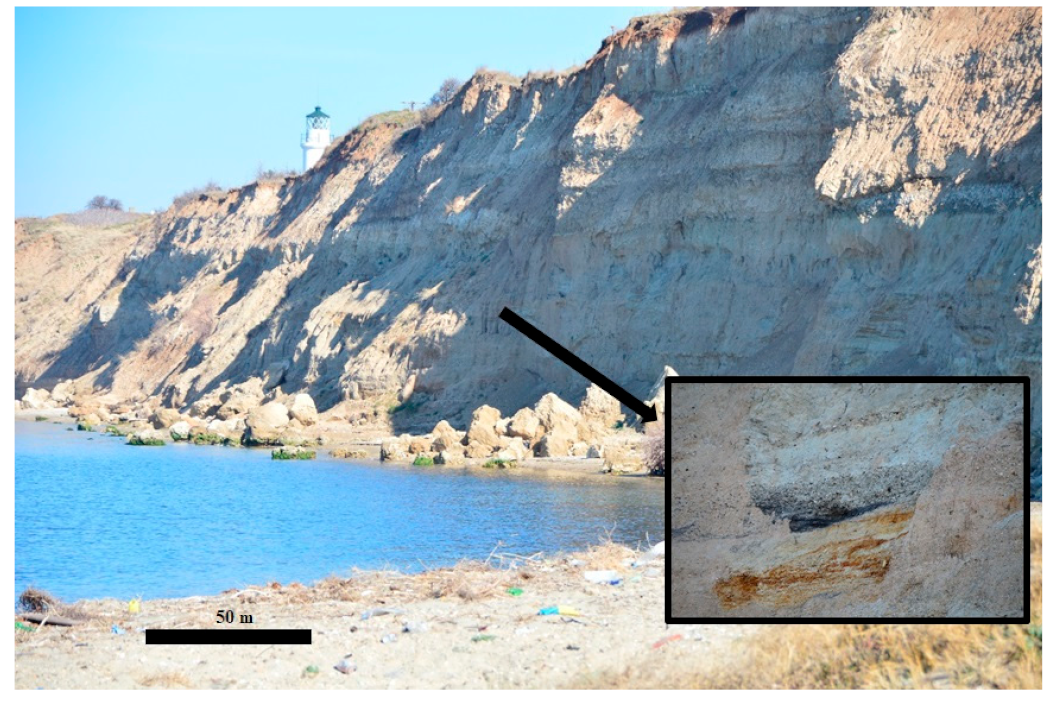
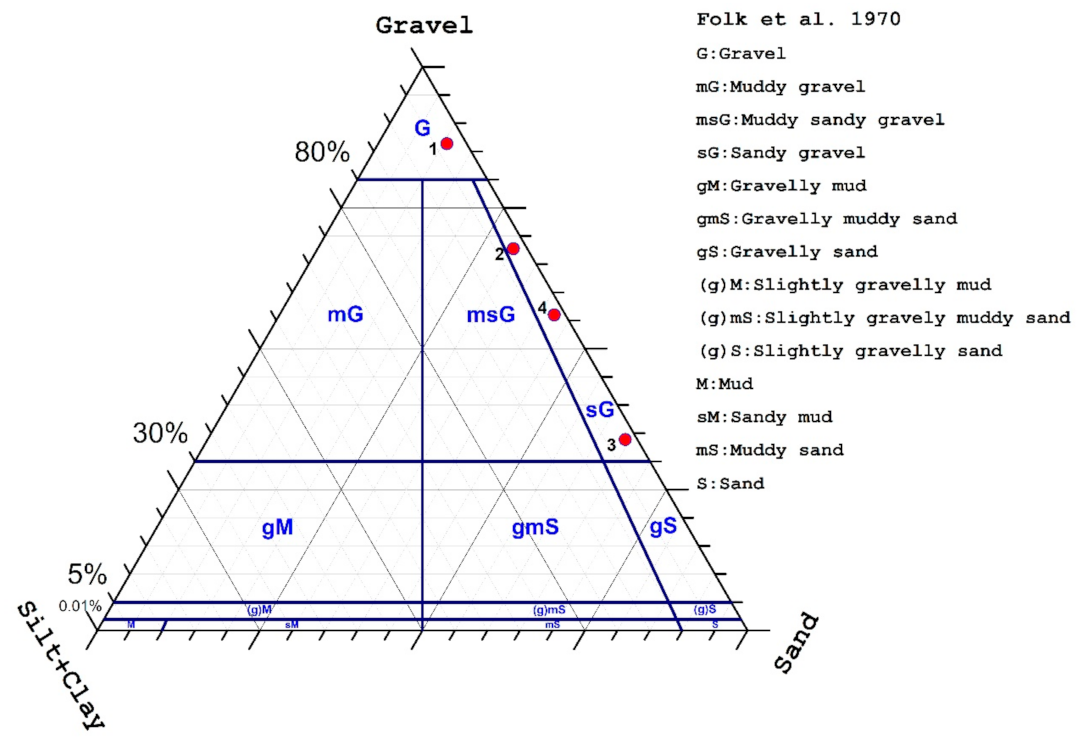
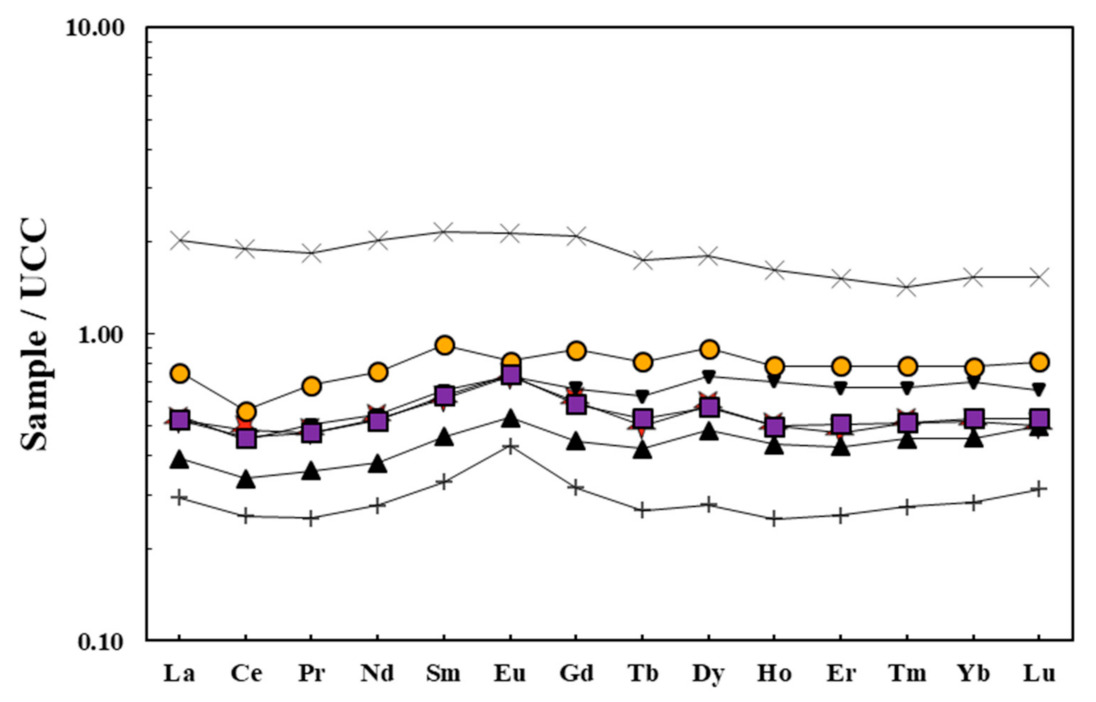

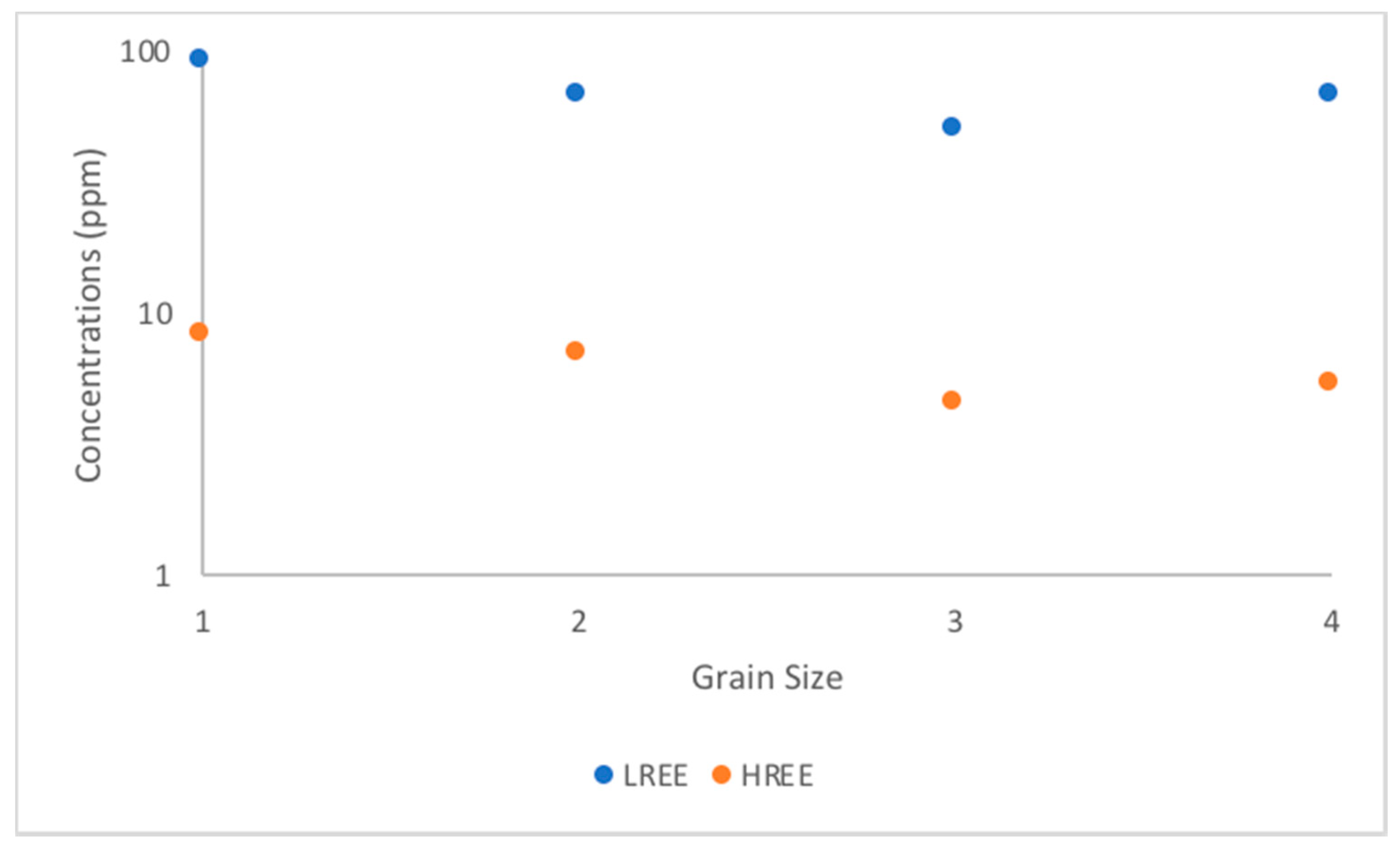
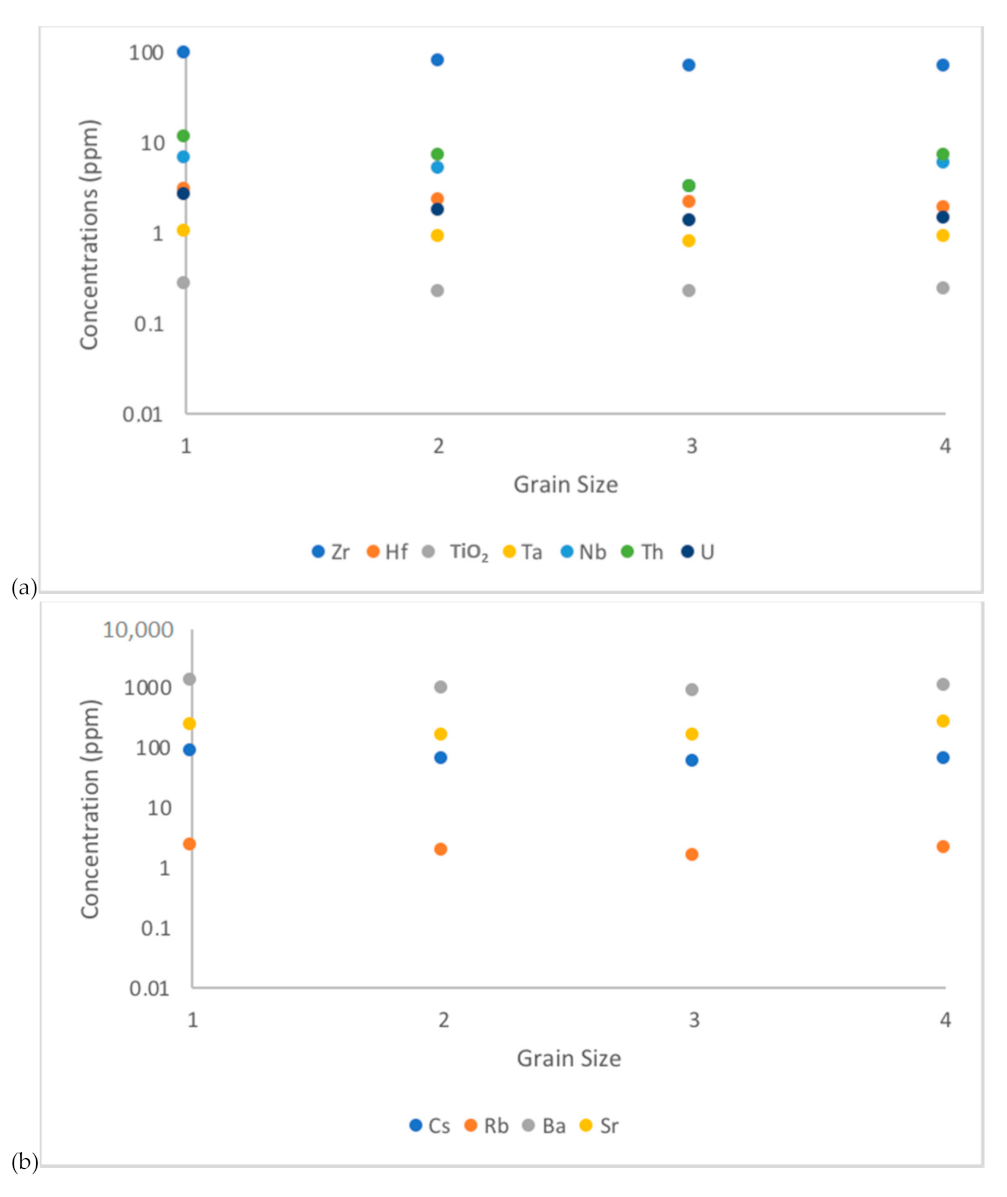



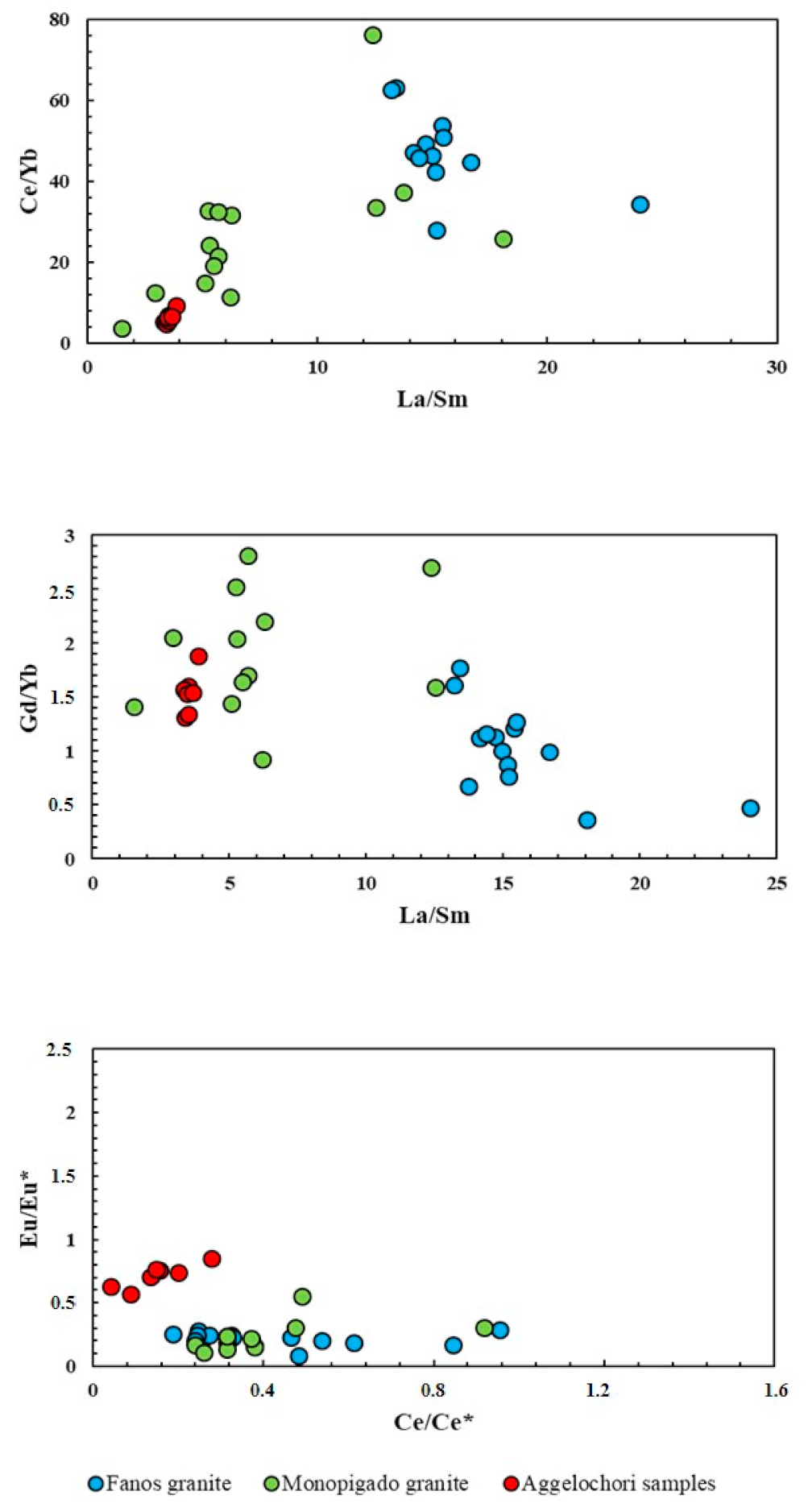
| Sample | Gravel (>2 mm) | Sand (2–0.63 mm) | Silt+Clay (<0.063 mm) | Lithological Class | |
|---|---|---|---|---|---|
| Folk et al. (1970) | Schlee (1973) | ||||
| AGG-1 | 86.38 | 10.57 | 3.05 | Gravel | Gravel |
| AGG-2 | 67.73 | 30.13 | 2.14 | Sandy gravel | Gravel |
| AGG-3 | 33.88 | 64.27 | 1.85 | Sandy gravel | Gravelly sediments |
| AGG-4 | 55.98 | 42.29 | 1.73 | Sandy gravel | Gravel |
| Sample | Magnetic Fraction % | Non-Magnetic Fraction % |
|---|---|---|
| AGG-1 | 70.61 | 29.39 |
| AGG-2 | 81.48 | 18.52 |
| AGG-3 | 72.28 | 27.72 |
| AGG-4 | 80.14 | 19.86 |
| Mineral | Qz | Pl | Kf | Px | Am | Do | M | Ch | Mt | Ht | Ilm | Ru | Ti | Zr |
|---|---|---|---|---|---|---|---|---|---|---|---|---|---|---|
| AGG-1 | 22 | 14 | 4 | - | - | - | 16 | 28 | 9 | - | - | 4 | - | 3 |
| AGG-2 | 38 | 26 | 4 | 4 | 1 | 3 | 9 | 4 | 5 | 2 | 2 | - | - | 2 |
| AGG-3 | 40 | 30 | - | 1 | 1 | 2 | 9 | 7 | 5 | - | - | - | 2 | 3 |
| AGG-4 | 31 | 21 | 7 | 2 | 3 | 3 | 13 | 7 | 5 | - | - | - | 5 | 3 |
| Sample AGG-3 | SiO2 | TiO2 | Al2O3 | Fe2O3t | MgO | MnO | CaO | Na2O | K2O | P2O5 | LOI | Total | |||||||||||||||||||||||||||
|---|---|---|---|---|---|---|---|---|---|---|---|---|---|---|---|---|---|---|---|---|---|---|---|---|---|---|---|---|---|---|---|---|---|---|---|---|---|---|---|
| Whole sample | 81.66 | 0.18 | 7.19 | 1.85 | 0.39 | 0.46 | 0.68 | 1.91 | 2.07 | 0.05 | 1.89 | 98.37 | |||||||||||||||||||||||||||
| >4 mm | 78.94 | 0.27 | 8.88 | 2.15 | 0.34 | 0.69 | 0.59 | 2.32 | 2.68 | 0.12 | 2.11 | 99.10 | |||||||||||||||||||||||||||
| 4–2 mm | 82.17 | 0.22 | 7.39 | 2.04 | 0.46 | 0.48 | 0.58 | 1.91 | 2.16 | 0.07 | 1.74 | 99.18 | |||||||||||||||||||||||||||
| 2–1 mm | 84.17 | 0.22 | 6.75 | 1.61 | 0.32 | 0.30 | 0.65 | 1.75 | 2.11 | 0.04 | 1.47 | 99.40 | |||||||||||||||||||||||||||
| 1–0.063 mm | 81.22 | 0.23 | 8.35 | 2.02 | 0.50 | 0.34 | 1.22 | 2.18 | 2.14 | 0.04 | 1.61 | 99.83 | |||||||||||||||||||||||||||
| Non-magnetic | 85.38 | 0.08 | 7.38 | 0.63 | <0.01 | 0.20 | 0.51 | 2.22 | 2.33 | 0.02 | 0.99 | 99.74 | |||||||||||||||||||||||||||
| Magnetic | 61.24 | 0.79 | 13.55 | 6.62 | 3.01 | 0.74 | 4.47 | 2.02 | 2.20 | 0.11 | 4.14 | 98.88 | |||||||||||||||||||||||||||
| d.l. | <0.01 | <0.01 | <0.01 | <0.01 | <0.01 | <0.01 | <0.01 | <0.01 | <0.01 | <0.01 | |||||||||||||||||||||||||||||
| Sample AGG-3 | Rb | Ba | Sr | Cs | Ga | Cr | V | Th | U | Ta | Nb | Zr | Y | Hf | |||||||||||||||||||||||||
| Whole sample | 58.4 | 1148.6 | 201.5 | 1.9 | 7.9 | 30 | 52 | 6.9 | 1.5 | 0.9 | 4.5 | 71.0 | 9.2 | 2.4 | |||||||||||||||||||||||||
| >4 mm | 86.1 | 1263.7 | 223.6 | 2.2 | 10.6 | 19 | 76 | 11.3 | 2.7 | 1.0 | 6.8 | 94.0 | 14.5 | 2.9 | |||||||||||||||||||||||||
| 4–2 mm | 61.5 | 973.5 | 156.7 | 1.8 | 8.4 | 27 | 57 | 7.1 | 1.8 | 0.9 | 5.0 | 77.0 | 13.2 | 2.3 | |||||||||||||||||||||||||
| 2–1 mm | 54.8 | 831.2 | 155.8 | 1.6 | 6.9 | 26 | 39 | 3.2 | 1.3 | 0.8 | 3.2 | 69.0 | 8.3 | 2.1 | |||||||||||||||||||||||||
| 1–0.063 mm | 61.5 | 1023.4 | 256.3 | 2.0 | 8.8 | 56 | 47 | 7.0 | 1.4 | 0.9 | 5.8 | 67.0 | 9.6 | 1.9 | |||||||||||||||||||||||||
| Non-magnetic | 93.3 | 1368.1 | 474.3 | 6.2 | 18.1 | 137 | 147 | 23.1 | 4.1 | 1.4 | 16.7 | 123.0 | 29.4 | 3.9 | |||||||||||||||||||||||||
| Magnetic | 53.9 | 807.8 | 207.2 | 1.0 | 6.6 | 10 | 16 | 4.6 | 0.7 | 0.6 | 2.9 | 53.0 | 5.0 | 1.6 | |||||||||||||||||||||||||
| d.l. | <0.2 | <0.5 | <0.1 | <0.01 | <0.2 | <10 | <10 | <0.05 | <0.05 | <0.1 | <0.1 | <2 | <0.5 | <0.2 | |||||||||||||||||||||||||
| Sample AGG-3 | La | Ce | Pr | Nd | Sm | Eu | Gd | Tb | Dy | Ho | Er | Tm | Yb | Lu | Σ REE | Eu/Eu* | |||||||||||||||||||||||
| Whole sample | 15.7 | 31.2 | 3.4 | 13.8 | 2.8 | 0.6 | 2.3 | 0.3 | 2.1 | 0.4 | 1.1 | 0.2 | 1.1 | 0.2 | 75.1 | 0.8 | |||||||||||||||||||||||
| >4 mm | 22.5 | 36.1 | 4.9 | 19.6 | 4.2 | 0.7 | 3.4 | 0.5 | 3.1 | 0.6 | 1.8 | 0.3 | 1.7 | 0.3 | 99.7 | 0.6 | |||||||||||||||||||||||
| 4–2 mm | 16.2 | 28.9 | 3.6 | 14.2 | 2.9 | 0.6 | 2.5 | 0.4 | 2.5 | 0.6 | 1.5 | 0.2 | 1.5 | 0.2 | 76.0 | 0.7 | |||||||||||||||||||||||
| 2–1 mm | 11.8 | 21.6 | 2.5 | 9.9 | 2.1 | 0.5 | 1.7 | 0.3 | 1.7 | 0.4 | 1.0 | 0.2 | 1.0 | 0.2 | 54.7 | 0.7 | |||||||||||||||||||||||
| 1–0.063 mm | 15.8 | 29.5 | 3.4 | 13.6 | 2.8 | 0.7 | 2.3 | 0.3 | 2.0 | 0.4 | 1.2 | 0.2 | 1.2 | 0.2 | 73.5 | 0.8 | |||||||||||||||||||||||
| Non-magnetic | 60.8 | 121.2 | 13.1 | 52.7 | 9.8 | 1.9 | 8.0 | 1.1 | 6.3 | 1.3 | 3.5 | 0.5 | 3.4 | 0.5 | 284.0 | 0.6 | |||||||||||||||||||||||
| Magnetic | 8.8 | 16.3 | 1.8 | 7.2 | 1.5 | 0.4 | 1.2 | 0.2 | 1.0 | 0.2 | 0.6 | 0.1 | 0.6 | 0.1 | 39.9 | 0.9 | |||||||||||||||||||||||
| d.l. | <0.1 | <0.1 | <0.03 | <0.1 | <0.03 | <0.03 | <0.05 | <0.01 | <0.05 | <0.01 | <0.03 | <0.01 | <0.03 | <0.01 | |||||||||||||||||||||||||
Publisher’s Note: MDPI stays neutral with regard to jurisdictional claims in published maps and institutional affiliations. |
© 2021 by the authors. Licensee MDPI, Basel, Switzerland. This article is an open access article distributed under the terms and conditions of the Creative Commons Attribution (CC BY) license (https://creativecommons.org/licenses/by/4.0/).
Share and Cite
Papadopoulos, A.; Lazaridis, S.; Kipourou-Panagiotou, A.; Kantiranis, N.; Koroneos, A.; Almpanakis, K. Mineralogy, Geochemistry and Provenance of Coastal Sands from Greece: New Insights on the REE Content of Black Coastal Sands from Aggelochori Area, N.-Greece. Minerals 2021, 11, 693. https://doi.org/10.3390/min11070693
Papadopoulos A, Lazaridis S, Kipourou-Panagiotou A, Kantiranis N, Koroneos A, Almpanakis K. Mineralogy, Geochemistry and Provenance of Coastal Sands from Greece: New Insights on the REE Content of Black Coastal Sands from Aggelochori Area, N.-Greece. Minerals. 2021; 11(7):693. https://doi.org/10.3390/min11070693
Chicago/Turabian StylePapadopoulos, Argyrios, Stylianos Lazaridis, Afroditi Kipourou-Panagiotou, Nikolaos Kantiranis, Antonios Koroneos, and Konstantinos Almpanakis. 2021. "Mineralogy, Geochemistry and Provenance of Coastal Sands from Greece: New Insights on the REE Content of Black Coastal Sands from Aggelochori Area, N.-Greece" Minerals 11, no. 7: 693. https://doi.org/10.3390/min11070693
APA StylePapadopoulos, A., Lazaridis, S., Kipourou-Panagiotou, A., Kantiranis, N., Koroneos, A., & Almpanakis, K. (2021). Mineralogy, Geochemistry and Provenance of Coastal Sands from Greece: New Insights on the REE Content of Black Coastal Sands from Aggelochori Area, N.-Greece. Minerals, 11(7), 693. https://doi.org/10.3390/min11070693









